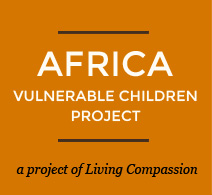It was a beautiful morning in Zambia. The sun was out and it was hot! As we arrived on the property, there was a swarm of friends running up to the car eager to say hello and shake our hands.

Our young greeters!
As we parked, we saw another car on the property—Martha, the Living Compassion accountant, was here! After some warm hellos, we went off to our respective tasks for the day.

Martha and Theresa.
One of the first stops was another peek into Joy’s classroom. Today, she was continuing with the “What’s Your Name?” lesson plan. As we all know from our own experience, repetition is the true key to learning. In fact, it seems the patience to stick with the same “simple” topic for as long as it takes is the mark of a great teacher.
The children gathered in a circle, and one child walked into the middle, singing the song. That child would then point to a classmate and ask, “What’s your name?” The second child would reply, “My name is…” “Nice to meet you.” “Thank you.” Then that child would come into the circle and start the process over again. It was fun seeing the children interact with each other, helping each other out when one was shy or didn’t remember what to say.
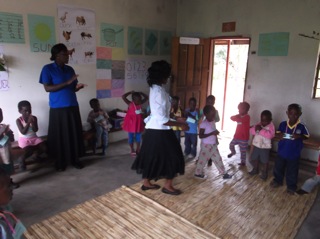
Joy leads a student around the circle during the “What’s Your Name?” lesson.

Angela, one of Joy’s students, giving us a lovely smile.
Then, it was on to the library to meet with Josephine and talk about the reading program. At the Bridge Walk, folks had recorded books for the children to listen to while reading along – such a great idea! The children could then hear the words with proper pronunciation, and read them at the same time. After a quick tutorial with Josephine on how to use the recorders, it was time to see how it would work. There were a couple of children in the library who were ready to jump in. Two boys began, and after teaching one of the boys what it meant when the voice on the recorder said “turn the page” he was set and ready to go. His friend was eager to join in, so they split the headphones, and it was a joy to watch the first boy instruct the second boy on when to turn the page. The best way to learn is to teach!
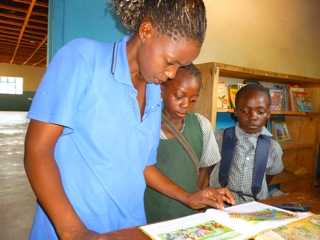
Josephine pointing out the words while the recorder plays.
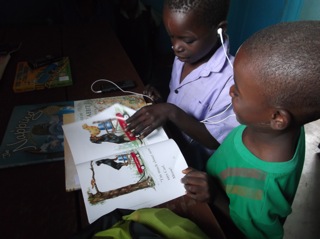
These guys have the hang of it!
The meeting with Theresa and Martha was fruitful and several new, innovative ideas resulted. One that we are all quite excited about is an education savings program. The way it would work is that Martha would meet with any member of the cooperative who wishes to participate and lay out a plan of tuitions needed. All schools start in January and it is an enormous challenge at best, for many an impossibility, to pay all their children’s school fees in one month. In fact, the necessity to pay these annual fees, relatively small by American standards (from $8 to $125 depending on grade level), is often the catalyst for children dropping out of school.
Well in advance of the new year, as early as now for 2016, Martha would work with each family to list each child, grade level, and funds needed and come up with a total, and from there create a plan of saving a certain amount of kwacha each month. In January, when the school fees are due, they withdraw this money from the savings program along with an extra 10% added by the U.S. side (that’s all of us!). If someone saves 1,000 kwacha, she will receive 1,100 upon withdrawal. Watch for an announcement in the months to come of this inspiring way to participate with our Sangha here in Kantolomba.
One other point worth mentioning from the meeting was Martha’s idea to have her daughters, now young adults, come speak to the young girls in Kantolomba. Martha has an inspiring life story. She grew up with a very similar background to folks in Kantolomba. Her father was adamant she be educated. So much so, that when, at 17, her boyfriend announced he wished to marry Martha, her father consented only if the boyfriend agreed to allow Martha to continue her studies. They even signed a contract. Martha said her husband took that contract very seriously and Martha now holds several advanced degrees in accounting.
Martha’s husband died when her children were young, and she was left to support her entire family on her own. She passed on that strict emphasis on education to her children. All five of them are still studying. The youngest is in grade 10. All others are in University, one about to graduate from law school and another starting a masters program. This is extraordinary!
Martha feels it could be powerful to have her daughters speak to the girls of Kantolomba and demonstrate that they were just like these girls, and that it IS possible and very worth it! It brought tears to our eyes when Martha reported that her eldest child, who now has a good job, paid for her brother’s tuition, books and uniform for grade 10 this year! Goosebumps. Already Martha is reaping the financial benefits of her dedicated investment.
It was then time for lunch. It is always so wonderful to see the children line-up, eat, wash their plates and walk away with smiles and laughter.
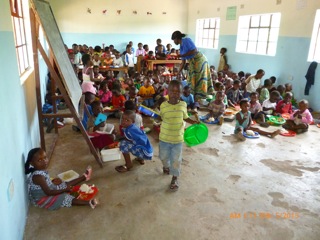
Lots of bellies getting full with lunch.
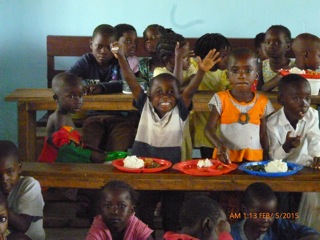
This guy is very much enjoying his lunch!
As we stood with Theresa while the children were eating, we remarked that is it amazing how much these little guys can eat. From what we see of most American children, it is a struggle to get them to eat anything that is not in the sugar food-group. Yet, here are these children with giant platefuls of balanced, nutritious food and they eat it heartily. Theresa said she can always tell which children are able to eat “at least something” at home and which eat only at Living Compassion. She pointed at one very sweet little girl, sitting intently focused, eating quite quickly. She felt sure that this child arrives very hungry each day. She told us that it gives her great pleasure that, once satiated, a child comes alive and is all smiles and playful. These are the children who would be part of the 7 in 10 lost before the age of 5 statistic we heard when we first arrived in Kantolomba, were it not for the heroic efforts of these women preparing giant pot after giant pot of nshima day after day.
As an illustration of that, EVERY woman in the cooperative has lost at least one child, many of them far more than one. So, that accounts for not less than 60 children lost just from our small group of women, mostly in the 10 years previous to Living Compassion’s arrival. Imagine if you took a group of 30 women in the United States and asked how many had lost a child? It would be rare, in a group of 30, if even one woman responded affirmatively. This gives you an anecdotal sense of the extremely high rate of early child mortality. In the 10 years (yes, we crossed the 10-year mark of the lunch program in October 2014) since Living Compassion has been here, two Living Compassion children have died. One from causes no one knows—she was not feeling well, went to lie down, and did not wake up again—and one baby died just hours after his birth last year. This is a truly extraordinary turn around. Clean water, proper nutrition, access to health care, health and nutrition education, and, it is easy to project, a vibrant community in which to participate—all part of the transformation Life is providing here. MUCH to be grateful for!
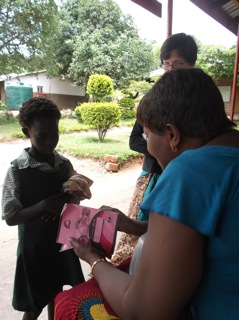
After lunch, Theresa checks a school book to see how things are going. What a seemingly small but critical piece this is. It is a message to the children that someone cares. Someone wants to know how they are doing, what they are learning, are they doing their school work. Theresa has such a lightness when she comes across a student who is clearly lagging behind. She always evokes a smile and laughter from the child as she encourages him or her to ask for help when needed.
Right after lunch, we noticed a group of about 7 or 8 boys quickly shuffle past us. One of the team said that they were going to the library because they had heard about the new books. Word continued to spread, and more children showed up! There was even a waiting line at one point! As children continued filing in throughout the early afternoon, most chose to listen to “The Little Engine that Could.”
Beatrice also held a “story hour” outside the library. There must have been at least 20 students in the library at this time. Yea!
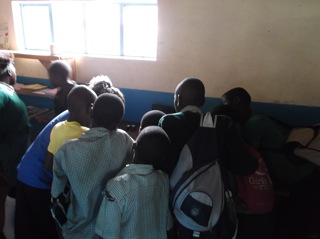
The boys eagerly listening to the book on tape.
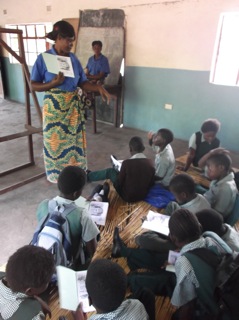
Beatrice reading one of the books we found on the last visit. Each of the children has a corresponding copy, and they are following along.
It would soon be time to head off to our appointment to visit the government school, but before that happened, Ethel wanted to make sure to teach us something very important—the art of walking slowly. She’d been seeing how fast we walk (trying to get those steps in!), and told us that it was not good to walk so fast in the heat, we need to walk slowly. So Ethel gave us a master class in how to walk slowly to better conserve our energy. Off around the property we went – one step at a time, in awareness of the heat, the pace, and the guidance!
And we had a wonderful surprise when we rounded the back of the building and Josephine appeared with two students. “Listen,” she proudly instructed, then turned to the two young girls. “I think I can, I think I can, I think I can” they each pronounced carefully with wide grins. Oh, the learning process is such great fun!
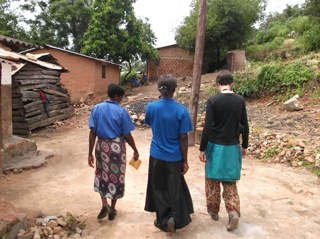
Ethel and Susan lead us around the property…slowly.
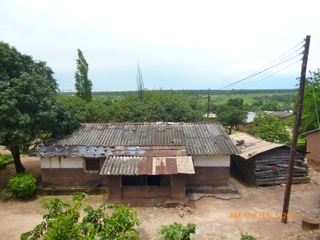
And as we walked around, we were reminded of the many beautiful sights on the property. Here is a view from the upper hill.
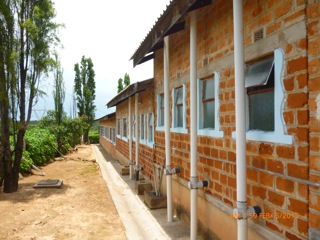
And even behind the building is a testament to how well-kept the building is: clean and free of the litter that is prevalent everywhere in Zambia due to the dire shortage of any official place to put garbage.

And a number of the team weeding another area for planting.
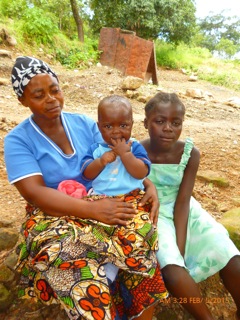
And Brenda with her oldest, Monica, and, baby Aaron.
We alluded earlier to one member of the cooperative losing a baby a few hours after birth. That was Brenda. She had been alone in her home when labor began, and it all happened so quickly that there was no time for her daughter to seek help or to get Brenda to the clinic. In advance of Aaron’s delivery, preparations were put into place. Aaron is the picture of health!
Then, it was on to our mini field trip. The team was headed to see Joy at the Twatema Basic School, the local government elementary school just down the road. We arrived just at the break time, so it was a good opportunity to talk with Joy and look around. About 30 minutes later, the children started filing in. When class began, we were struck by how orderly and well behaved they were, all seeming to be paying attention. Guessing that there were somewhere between 40 and 50 children in the room, it occurred to us to get an exact count. 75… 75! There were 75 children sitting in that room listening to one teacher! Whew. And the entire curriculum is in English, a language in which not a single child in the room is fluent. These teachers are heroic.
Joy took them through a math lesson where they were learning how to identify numbers in thousands, hundreds, tens and ones. It was quite a treat to see one of our teachers in a different environment. Joy had decided to participate in this way in order to grow her own skills as a teacher, as well as support the Living Compassion children in their school environment. About 85% of the Twatema children are in the Living Compassion program. Theresa said the children love Joy! She has a very playful and dedicated way with them. She demands their attention but shows great respect through her willingness to participate right along with them. The way Theresa put it, “If it’s time to jump, Joy jumps too.”
Seeing this school environment, it is even more tangibly obvious to us the critical role that extra lessons play at Living Compassion.
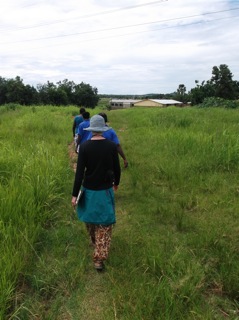
A nice chance for some walking meditation on the way to the government school.
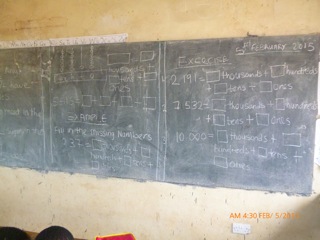
The lessons for the afternoon.

Joy leading the students through a math lesson.

On the walk back from the government school, we passed this home.
It struck us as such a wonderful illustration of care. In a small, also neat, well-cared for, thatched structure right next to the house, the owner of the home was brewing kichasu, the local corn liquor that is cheap to make, thus cheap to buy, thus very popular as the drink of choice in the local bars. It is dangerously strong, one only needs a little bit to get very drunk, making it far more affordable than beer. Anyone who is brewing this liquor as their livelihood is very poor. The work is hard, even dangerous due to accidents with fires and explosions, and the profits are tiny. So, here is this woman who is extremely poor, facing all the hardships of life in her environment, and her home is meticulously cared for. It is clean and freshly painted, potted plants growing at the entrance. We projected she is living in a process of care and attention inside of herself. And her home is a gift to all; at least it was a gift to us, as we walked past. The vibrancy of life to bloom everywhere!
Back at the property, the older girls were practicing the words to the song we shared with them. They gathered around Jen and impressed us with how much they had picked up. Learning!
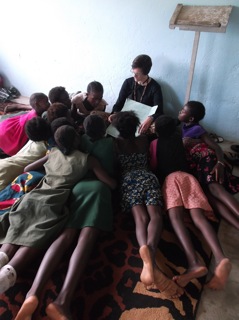
The girls show us what they’ve learned so far. Very impressive, in just 3 days!
Soon it was time to call it a day. As we mentioned in a previous blog, we are doing our best to get those steps in, so instead of jumping in the car and heading back to the lodge, a group of cooperative women suggested they escort us over the hill to Lubuto where Theresa would meet us with the car. Though we still know only several dozen names, it is fun that as we walk through the community we recognize hundreds of little faces as belonging to Kantolomba. They greet us with big smiles, a bit surprised, we project, to see us outside the Living Compassion context. After a nice walk in a very hot sun (many thanks to Ethel for teaching us how to walk slowly), we met Theresa and headed back to the Lodge.
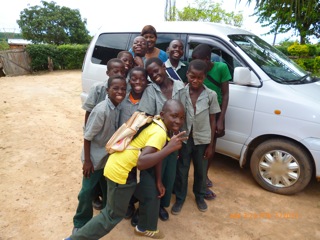
This group of boys insists on having their photo taken with Auntie Theresa before we leave for the day.
